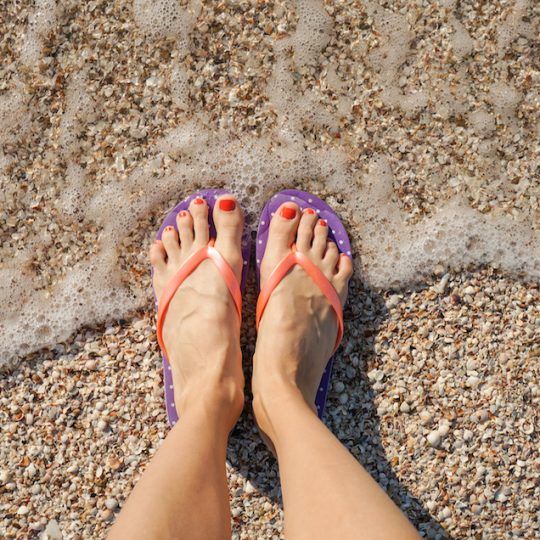What is Arthritis – and why you might get foot pain as a result

Arthritis means inflammation of a joint. There are various classifications of arthritis, which are broadly split into two general categories:
-
Osteoarthritis: This is generally described as ‘wear and tear on the joint’. It is associated with biomechanical imbalances, where a joint is overloaded in an unusual way. For example, a leg-length difference or a big toe joint with reduced motion may lead to compensatory mechanisms which eventually lead to foot pain and injury. Of course ankle, knee and hip pain is also common.
-
Inflammatory arthritis: In this classification, there is an autoimmune component, where the body’s own antibodies attack its own tissue. The most commonly known are rheumatoid arthritis, psoriatic arthritis and conditions such as gout. With this type of arthritis a specific pattern of change may occur in the foot such as; loss of fibrofatty padding beaneath the ball of the foot, leading to a reduction in shock absorbancy, hammering of lesser digits, bunions and loss of arch and adult acquired flat foot. These changes are often treated by a podiatrist and a specific drug regime, often with great success,
Is there a cure for arthritis in the feet?
With osteoarthritis, treatment incorporates finding the biomechanical imbalance which has caused excessive wear on a joint via biomechanical assessment with video gait analysis that we offer at OsteoGait Podiatry. This allows for the recognition of the factors which may be contributing to arthritis. When the cause can be established an effective treatment regime for the painful foot can be constructed.
How common is osteoarthritis in the feet?
Research demonstrates that around 80% of the older population has a degree of arthritis in their feet, with around 20% of people in general having osteoarthritis.
Are bunions the same as osteoarthritis?
Most patients who have bunions are prone to developing arthritic changes within their big toe joint as the joint is not functioning efficiently, leading to more wear and tear of the cartilage. Osteoarthritis and bunions are not the same but regularly co-exist.
What are the treatments for osteoarthritis of the foot?
- Orthotic or Insoles: research demonstrates that orthotics and insoles can help with arthritis in the feet, ankle, knee, hip and even lower back. This is specifically pertinent to pain on top of the foot or midfoot and the big toe joint. At OsteoGait Podiatry there is a high satisfaction rate amongst patients who receive orthotics or insoles for arthritic foot pain.
- Drug Management: a range of drugs can be prescribed to manage arthritis varying from NSAIDs such as Ibuprofen (Non-Steroidal Anti-Inflammatory) to Prednisolone (Steroid) and others which address the disease process such as Methotrexate (DMARD) or suppress the bodies immune system (Biologics or Anti-TNF). It is of course desirable, if possible, to avoid taking drugs as all drugs may have potential side effects. The appropriate course of management can be discussed with your podiatrist and the appropriate recommendation made for sustained management via a referral to rheumatology or advice for your GP be made.
- injection Therapy: A wide range of injections are utilised in the management of arthritis. Your Podiatrist may use a Corticosteroid injection to reduce painful joint inflammation. This is often caused by arthritis and the injection can be helpful as part of a programme incorporating insoles or orthotics to prevent the inflammation from returning. At OsteoGait Podiatry we utilise a fast acting Local Anaesthetic with our steroid injections into the foot, meaning the injection is often of very minimal discomfort, more information.
- Surgery: Foot surgery can be successful in the treatment of arthritis, where all other treatment has failed to cure the foot pain. With minimal deformity the arthritic portion (bump) of the joint is shaved off. With a more advanced deformity, a more invasive procedure is used to improve range of motion and alignment at the joint and in some cases an artificial joint replacement is used. Your podiatrist can discuss these options with you in great detail following a biomechanical assessment.
What if I wanted to see OsteoGait Podiatry about my arthritic feet?
This six step plan for pain free feet is apart of our arthritis protocol:
- 1) Accurate diagnosis of osteoarthritis via biomechanical and video gait analysis.
- 3) Custom orthotic therapy to address the imbalance within the foot or lower limb
- 4) Footwear advice and customisation to minimise the mechanical tension on joints affected by osteoarthritis.
- 5) Specialist guided injections using corticosteroid to reduce joint inflammation and pain.
- 6) Referral for surgical consult should the above fail.
If you require advice on any of these topics or a pair of custom made insoles or orthotics for a painful arthritic feet, a flatfoot or high arched foot, click (more information).
